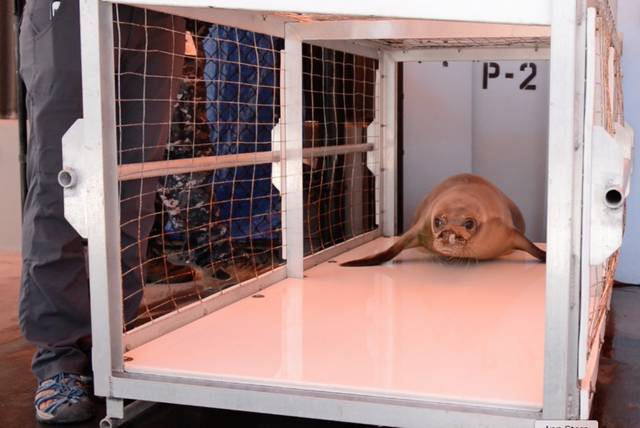HONOLULU — Talk about an escort. ADVERTISING HONOLULU — Talk about an escort. Personnel from the Coast Guard 14th District, the National Oceanic and Atmospheric Administration and The Marine Mammal Center transported a rehabilitated monk seal from Kailua-Kona to Honolulu
HONOLULU — Talk about an escort.
Personnel from the Coast Guard 14th District, the National Oceanic and Atmospheric Administration and The Marine Mammal Center transported a rehabilitated monk seal from Kailua-Kona to Honolulu aboard a Coast Guard HC-130 Hercules airplane Wednesday to help the mammal get back to her original home in the wild.
“This is one of our 11 statutory missions and it’s a great one because it’s part of our living marine resources program and it allows us to be not only and enforcement arm for the protection of our natural resources but also to help with conservation,” said Eric Roberts, marine resource specialist, Coast Guard 14th District, in a press release.
The collaboration has successfully rehabilitated and released more than 15 young Hawaiian monk seals and become a critical piece in the monk seal recovery plan now in its 10th year.
“This is a unique opportunity for the Coast Guard to play a part in the recovery of this critically endangered species,” Roberts said.
The Coast Guard transports six marine mammals on average each year in conjunction with other missions such as necessary training flights.
The young female seal was rescued by NOAA in May and taken to The Marine Mammal Center’s Ke Kai Ola monk seal rehabilitation facility on Hawaii Island for care and stabilization.
Upon arrival to Oahu, the seal will be temporarily housed at the NOAA IRC facility on Ford Island and then be loaded onto a NOAA Fisheries ship and transported to the Northwestern Hawaiian Islands in the Papahanaumokuakea Marine National Monument.
The most recent annual population assessment shows that the Hawaiian monk seal, bucking past trends, has increased in numbers by 3 percent annually for the past three years. The population is now estimated to be around 1,400 seals.
“The public can help us with Hawaiian monk seals because they can be aware when seals are in an area that they might be swimming or fishing and give seals a very safe distance,” Dr. Michelle Barbieri, veterinarian for the Hawaiian monk seal research program at NOAA. “It’s very important we keep seals wild by giving them the space that they need to do their natural behaviors.”




